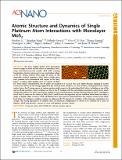| dc.contributor.author | Wang, Shanshan | |
| dc.contributor.author | Sawada, Hidetake | |
| dc.contributor.author | Samuels, Thomas | |
| dc.contributor.author | Allen, Christopher S. | |
| dc.contributor.author | Kirkland, Angus I. | |
| dc.contributor.author | Warner, Jamie H. | |
| dc.contributor.author | Li, Huashan | |
| dc.contributor.author | Han, Grace | |
| dc.contributor.author | Grossman, Jeffrey C. | |
| dc.date.accessioned | 2018-04-20T18:40:15Z | |
| dc.date.available | 2018-04-20T18:40:15Z | |
| dc.date.issued | 2017-03 | |
| dc.date.submitted | 2017-02 | |
| dc.identifier.issn | 1936-0851 | |
| dc.identifier.issn | 1936-086X | |
| dc.identifier.uri | http://hdl.handle.net/1721.1/114821 | |
| dc.description.abstract | We have studied atomic level interactions between single Pt atoms and the surface of monolayer MoS₂ using aberration-corrected annular dark field scanning transmission electron microscopy at an accelerating voltage of 60 kV. Strong contrast from single Pt atoms on the atomically resolved monolayer MoS₂ lattice enables their exact position to be determined with respect to the MoS₂ lattice, revealing stable binding sites. In regions of MoS₂ free from surface contamination, the Pt atoms are localized in S vacancy sites and exhibit dynamic hopping to nearby vacancy sites driven by the energy supplied by the electron beam. However, in areas of MoS₂ contaminated with carbon surface layers, the Pt atoms appear at various positions with respect to the underlying MoS₂ lattice, including on top of Mo and in off-axis positions. These variations are due to the Pt bonding with the surrounding amorphous carbon layer, which disrupts the intrinsic Pt-MoS₂ interactions, leading to more varied positions. Density functional theory (DFT) calculations reveal that Pt atoms on the surface of MoS₂ have a small barrier for migration and are stabilized when bound to either a single or double sulfur vacancies. DFT calculations have been used to understand how the catalytic activity of the MoS₂ basal plane for hydrogen evolution reaction is influenced by Pt dopants by variation of the hydrogen adsorption free energy. This strong dependence of catalytic effect on interfacial configurations is shown to be common for a series of dopants, which may provide a means to create and optimize reaction centers. | en_US |
| dc.publisher | American Chemical Society (ACS) | en_US |
| dc.relation.isversionof | http://dx.doi.org/10.1021/ACSNANO.7B00796 | en_US |
| dc.rights | Article is made available in accordance with the publisher's policy and may be subject to US copyright law. Please refer to the publisher's site for terms of use. | en_US |
| dc.source | MIT Web Domain | en_US |
| dc.title | Atomic Structure and Dynamics of Single Platinum Atom Interactions with Monolayer MoS | en_US |
| dc.type | Article | en_US |
| dc.identifier.citation | Li, Huashan, et al. “Atomic Structure and Dynamics of Single Platinum Atom Interactions with Monolayer MoS2.” ACS Nano 11, 3 (March 2017): 3392–3403 © 2017 American Chemical Society | en_US |
| dc.contributor.department | Massachusetts Institute of Technology. Department of Materials Science and Engineering | en_US |
| dc.contributor.department | Massachusetts Institute of Technology. Research Laboratory of Electronics | en_US |
| dc.contributor.mitauthor | Li, Huashan | |
| dc.contributor.mitauthor | Han, Grace | |
| dc.contributor.mitauthor | Grossman, Jeffrey C. | |
| dc.relation.journal | ACS Nano | en_US |
| dc.eprint.version | Author's final manuscript | en_US |
| dc.type.uri | http://purl.org/eprint/type/JournalArticle | en_US |
| eprint.status | http://purl.org/eprint/status/PeerReviewed | en_US |
| dc.date.updated | 2018-04-19T14:20:32Z | |
| dspace.orderedauthors | Li, Huashan; Wang, Shanshan; Sawada, Hidetake; Han, Grace G. D.; Samuels, Thomas; Allen, Christopher S.; Kirkland, Angus I.; Grossman, Jeffrey C.; Warner, Jamie H. | en_US |
| dspace.embargo.terms | N | en_US |
| dc.identifier.orcid | https://orcid.org/0000-0003-1281-2359 | |
| mit.license | PUBLISHER_POLICY | en_US |
